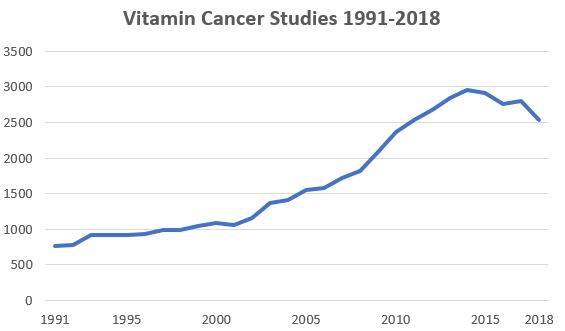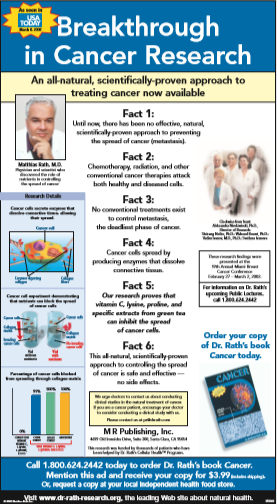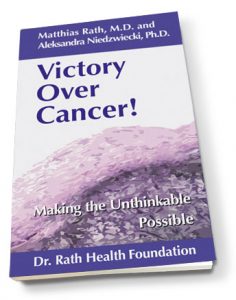A recent Wall Street Journal article reported that the death rate from cancer in the United States fell by 2.4 percent between 2017 and 2018, the biggest single annual decline in the country’s history. According to the pharma-oriented American Cancer Society, the fall is supposedly due to “powerful” new drug treatments, especially those for lung cancer. In reality, however, the decline in US cancer deaths continues a trend that began three decades ago. The mortality rate for the disease has fallen by 31 percent in the country since its peak in 1991. Far from this being due to pharmaceutical medicine, it parallels a growing public awareness of Dr. Matthias Rath’s scientific discoveries and the consequent dramatic increase in the use of dietary supplements in the United States over the past three decades. The fact is that more Americans are now surviving cancer despite chemotherapy – not because of it.

Between 1991 and 2018, the number of published scientific papers studying vitamins and cancer increased by more than 300 percent globally (Source: PubMed.gov)
During the late 1980s and early 1990s, the number of Americans supplementing their diets with vitamins and other micronutrients was significantly lower than it is today. Between 1988 and 1994 only around 40 percent of the population were using dietary supplements. By 2018, however, a consumer survey carried out by the Council for Responsible Nutrition, a trade association, found this number had almost doubled, reaching 75 percent. Among adults aged between 33 and 54, 77 percent reported taking supplements. Usage in the 55 and over age group was even higher, at 78 percent.
This dramatic rise in supplement use in the United States didn’t happen by accident, however. It parallels a growing awareness of Dr. Rath’s scientific discoveries and more than two decades of groundbreaking cancer research carried out at the Dr. Rath Research Institute in California. Reflecting this, between 1991 and 2018, the number of published scientific papers studying vitamins and cancer increased by more than 300 percent globally.
Towards the natural control of cancer
Mortality from cancer reached its peak in the United States in 1991. The following year, Dr. Rath and two-time Nobel Laureate Linus Pauling published a visionary scientific paper describing how, in combination with vitamin C, use of the amino acid lysine could lead to a breakthrough in the natural control of cancer and other diseases. Titled ‘Plasmin-Induced Proteolysis and the role of Apoprotein(a), Lysine, and Synthetic Lysine Analogs’, the paper explained that, by addressing specific biological mechanisms used by most cancers, the proliferation of the disease could be inhibited. Along with other key scientific publications authored by Dr. Rath during this period, the 1992 paper helped ensure that awareness of the health-promoting properties of vitamins and other micronutrients grew rapidly among therapists and the American public alike.

Dr. Rath’s March 2002 announcement in the USA Today newspaper triggered a tsunami of interest in the natural control of cancer.
The reaction of the US Food and Drug Administration (FDA) to this development was swift. Realizing that non-patentable natural health approaches threatened the multibillion-dollar business model of the pharmaceutical industry, in June 1993 it published an ‘Advance Notice of Proposed Rulemaking’. This proposed that vitamins and minerals in dietary supplements should be limited to low multiples of the so-called ‘Recommended Daily Intakes’. Higher dose supplements were to be available only with a doctor’s prescription. The American public reacted with outrage to these plans.
Following a vociferous pro-vitamin campaign in which the US Congress received more letters from consumers than on any other single issue apart than the Vietnam War, legislation was eventually passed that guaranteed unrestricted access to dietary supplements for all Americans. Titled the ‘Dietary Supplement Health and Education Act’ (DSHEA), it was signed into law by US President Bill Clinton on 25 October 1994. Upon signing the legislation, Clinton specifically stated that “in an era of greater consciousness among people about the impact of what they eat on how they live, indeed, how long they live, it is appropriate that we have finally reformed the way Government treats consumers and these supplements in a way that encourages good health.” With the FDA’s pharma-inspired plans having thus backfired so spectacularly, the American public’s interest in and use of dietary supplements continued to grow.
A further key step towards the natural control of cancer came in 1999 with the founding of the Dr. Rath Research Institute. Under the leadership of Dr. Alexandra Niedzwiecki, the field of cancer was chosen as its first scientific focus. By early 2002 it had become clear to the institute’s research team that a micronutrient combination comprising vitamin C, the amino acids lysine and proline, and specific extracts from green tea could inhibit the spread of cancer cells. These findings were subsequently presented at the 19th annual breast cancer conference in Miami, Florida, between 27 February and 2 March, 2002. Following the conference, they were also then shared directly with the American people via a full-page advertisement in the USA Today newspaper. Published on 8 March 2002, the announcement unleashed a tsunami of interest in the natural control of cancer.
Over the following years, further studies conducted at the Dr. Rath Research Institute have proved that specific combinations of micronutrients can inhibit the invasion of more than 40 types of human cancer, including those of the lung, colon, pancreas, brain, blood, skin, ovaries, and others. With the institute’s work also showing that micronutrients can block the growth of tumors, the formation of new blood vessels to feed them (angiogenesis), as well as induce the natural death of cancer cells (apoptosis), Dr. Rath and Dr. Niedzwiecki published a jointly authored book, ‘Victory Over Cancer’, in 2011.

The download page for the ‘Victory Over Cancer’ book has become one of the most-visited pages on our website






